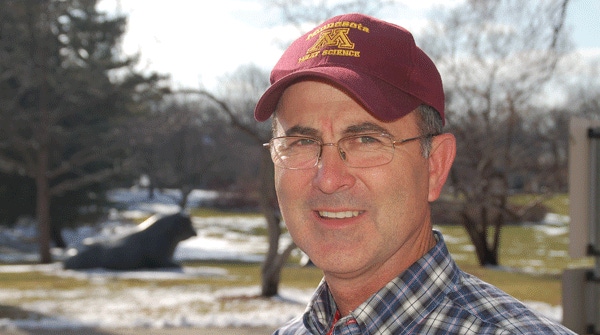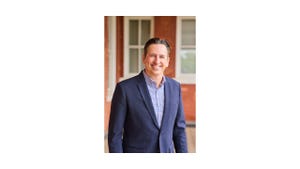Lee Johnston Keeps Real-World Perspective While Seeking Pork Production Solutions

Lee Johnston spends a lot of time looking out for pork producers. In his position as both a professor of swine nutrition and management, and as director of operations for the University of Minnesota’s West Central Research and Outreach Center (WCROC) in Morris, MN, Johnston deals with a host of cutting-edge, sometimes controversial issues. He says throughout his career, whether researching sow housing options or feeding strategies, one question has always been top of mind: “Would a farmer be able to implement this?”
His research focus has run the gamut from diet formulation and reproductive issues to carbon footprints, sow housing and animal welfare. His common-sense strategy of talking to producers first and then taking the time to look at how a seemingly simple decision can impact many factors within a production system has helped earn him the respect of both pork producers and peers in the research community around the world.
This approach has been particularly useful as the U.S. pork industry wrestles with sow housing questions. The University of Minnesota (UM) has the largest sow herd in a university setting in the U.S., with just under 900 sows total at two locations, divided among group housing, hoop housing and gestation-stall based systems. This gives Johnston the unique ability to investigate sow housing management decisions comprehensively.
“We’re not lobbying for one housing type over another. Our job is to bring science to the table to make sure that any production transitions happen in a way that is good for the producer and the sow, and can be economically viable,” he says.
Johnston has a knack for anticipating pork industry research needs and seeking input from people who know a topic best. This skill and good cooperation from other UM faculty has helped insure that the swine research barns are booked solid with research projects well into 2015. Time and again he emphasizes that pork producer input is crucial when it comes to both determining the research focus and implementing research results. He remembers his father, Ed’s, advice to him when he headed off to college for his bachelor's degree: “ ‘Remember, just because it says it in the book doesn’t make it so.’ I try to always remember when you get to the farm, the idea that worked well in the lab isn’t always do-able,” he says.
Farming Roots
Johnston grew up on a ninth-generation Pennsylvania dairy farm that had originally been a 321-acre land grant given by the U.S. government to Capt. Robert Johnston, an artillery captain, in return for his service during the Revolutionary War. Over the years, the farmland was gradually swallowed by the encroaching city.
By the time Johnston left for college, his family was milking 100 cows in a double-six herringbone parlor on 9 acres on the home farm, though they had another farm nearby. The family owned a bottling plant, and bottled and sold its own milk on-farm. The farm ended up being surrounded by the city. He remembers working with the cattle in the early mornings as people stood on the balconies of their town houses and looked down into the cattle pens.
Johnston was the only “farm kid” in his high school class of 740 students. When he set off for college, Johnston says he knew two things: He loved agriculture, and he did not want to milk cows. The specific career direction he was going to take within agriculture was not immediately clear.
However, he excitedly took full advantage of the newfound ability to spend time with other students who understood agriculture. “It was fabulous when I got to college at Penn State University, because there were other farm kids who were interested in, and talked about, the same things I did. It was really good to get to college and be part of the ag circles,” he says.
He competed on both the meats and livestock judging teams while at Penn State. Chuckling over the excited phone call he made to his mother prior to his first chance to travel with the meats judging team, Johnston remembers how those judging team trips helped broaden his horizons.
Johnston’s judging team experiences not only opened the door to travel, but also had other unexpected benefits as well. Johnston and his wife, Judy, were introduced to one another by a mutual friend on the judging team.
As for defining Johnston’s career path, it seems that fate intervened. Finding himself with some spare time on his hands during his sophomore year in college, Johnston put in applications at the Penn State dairy, beef and swine research farms.
He ended up being offered a part-time position at the swine barn. With absolutely no experience working with pigs, Johnston admits that the offer was not made with a high degree of confidence in his potential as a hog man. “Vern Hazlett was the swine barn manager, and he ended up splitting the job in half, giving me seven hours per week and giving the other half of the hours to another student because he wasn’t sure I was going to pan out,” Johnston laughs.
The combination of his experiences working with the Penn State purebred Duroc and Yorkshire herd, along with Hazlett’s mentorship, got Johnston excited about pigs. He soon realized that he wanted to pursue a career in the swine industry.
Johnston did not originally intend to go to graduate school when he accepted a position as assistant herdsman for the Texas Tech University swine research herd after graduating from Penn State. However, the opportunity to obtain a master’s degree at a significant cost savings, plus the urging of then-Texas Tech faculty member Don Orr, led to Johnston graduating with his master’s degree in 1984.
From there, the next stop was the doctoral program at Michigan State University. Johnston was inspired by the mentorship of Elwynn Miller. He remembers looking in awe at the rows of published research volumes on Miller’s shelves. A three-quarters Extension appointment during graduate school at MSU and his work on the Spartan Swine Ration Evaluation tool provided a wealth of practical experience for Johnston.
The Move to Morris, MN
Upon graduation from MSU, Johnston knew he wanted a swine-related university job. His search led him to the University of Minnesota in 1988, and placement at the WCROC in Morris. “It has been a great place for my whole family,” Johnston says. “We are able to be out in the country, with ties to a major land-grant university in a leading, progressive hog-producing state.”
Johnston’s career has also given him the opportunity to travel and learn about pork production throughout the U.S., and in other parts of the world. “My career has opened so many doors,” Johnston reflects. Shaking his head, he adds, “When I graduated from Penn State, I had no intention of going anywhere west of the Mississippi River.” As it turned out, his career has pushed him well beyond those intended boundaries.
Johnston spent a year on sabbatical in Australia from 2004 to 2005, working on sow housing, gilt development, and various other issues. Johnston’s contacts have helped facilitate collaborations between the WCROC and Australian researchers to learn more about loose-sow housing. “The Australian industry has said they are not going to allow stalls from weaning on. We want to take a look at production systems to learn what works best for the animal and the producer if society continues to ask for these types of transitions here,” Johnston says.
Johnston was promoted to director of the WCROC in 2010, and oversees an innovative set of research and outreach projects relating to such topics as renewable energy. As part of this focus, researchers are looking at energy requirements during different pork production phases. “We have a project called the "Greening of Agriculture" which is looking at dairy, crops and pork production, and ways to reduce the carbon footprint. That may be a bit controversial, but the market is telling us it is interested in agriculture’s carbon footprint, so we are trying to look at ways to help producers. We have plans to look at solar power in nurseries, for example, and have completed work on reducing nocturnal temperatures in the nursery,” he explains. He says the WCROC will continue to identify research needs that could benefit producers in the future.
Family Passion for Agriculture
The passion and vision for the future of agriculture is a central theme in the Johnston family. His children, Justin and Natalie, were both active in 4-H and FFA livestock projects and judging teams. Lee coached Justin and Natalie’s 4-H Quiz Bowl teams. Justin served as the 2009 Minnesota Pork Ambassador, and Natalie was the second runner-up Minnesota Pork Ambassador in 2011.
Justin is scheduled to graduate from UM with a master’s degree in meat science this summer, before heading off to Texas Tech University to delve further into the meat science research field while pursuing a doctorate. He also earned his bachelor’s degree in animal science from UM.
Natalie is a junior at UM. She has completed an internship with the Minnesota Pork Board and will be participating in an internship with AgStar this summer. She hopes to continue to work in agriculture after graduation.
Johnston says his children’s love of agriculture is a source of great pride. When asked what accomplishment he is most proud of, he quickly answers, "My kids."
Though he probably wouldn’t tell you about it, the list of Johnston’s professional accomplishments is impressive as well. He has numerous awards for innovation in outreach from the National Pork Board, and has been awarded the Outstanding Faculty Award from UM’s Animal Science Graduate Club in 2003 and 2008. Most recently, Johnston was named the 2014 Distinguished Alumnus by the Penn State Department of Animal Science.
Johnston says he hopes he can always make a positive difference to agricultural producers going forward.
About the Author(s)
You May Also Like


